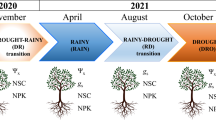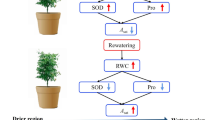Abstract
Main conclusion Cold acclimation is revealed through induced stem respiration during pre-winter frost of native Pistacia integerrima trees in continental semi-arid environments.
Semi-arid environments challenge vegetation by simultaneous abiotic stresses. In this study, we examine the combined effects of water stress and frost on the physiology of Pistacia integerrima stems. This species is native to semi-arid environments where drought and frost frequently co-occur. We quantified carbohydrates and proline in P. integerrima stems responding to frost and experiencing water potentials between −0.2 and −1.8 MPa. We report that dehydrated trees (i.e., Ψstem <=−1 MPa) had more soluble sugars and proline than the well-watered trees (−0.2 MPa). The dehydrated trees also froze at lower temperatures and were less damaged by freezing. Interestingly, we observed a significant increase in stem CO2 efflux at near-freezing temperatures that could be linked to frost protection. This novel finding challenges current paradigm of plant respiration-kinetics which predicts, according to Arrhenius equation, lower respiration rates during frost. Our results support the notion that drought and frost are analogous stresses that can independently activate corresponding physiological processes in trees and amplify protection. This inevitable stress response ‘collaboration’ may be the key to understanding how non-dormant perennial plants survive the highly variable weather patterns of early winters in semi-arid environments.





Similar content being viewed by others
Abbreviations
- SC:
-
Soluble carbohydrates
References
Améglio T, Bodet C, Lacointe A, Cochard H (2002) Winter embolism, mechanisms of xylem hydraulic conductivity recovery and springtime growth patterns in walnut and peach trees. Tree Physiol 22:1211–1220
Amthor JS (1984) The role of maintenance respiration in plant growth. Plant Cell Environ 7:561–569
Arrhenius SA (1889) Über die Dissociationswärme und den Einfluss der Temperatur auf den Dissociationsgrad der Elektrolyte. Wilhelm Engelmann, Leipzig, p 1889
Atkin OK, Tjoelker MG (2003) Thermal acclimation and the dynamic response of plant respiration to temperature. Trends Plant Sci 8:343–351
Atkin OK, Bruhn D, Hurry VM, Tjoelker MG (2005) Evans Review No. 2: the hot and the cold: unravelling the variable response of plant respiration to temperature. Funct Plant Biol 32:87–105
Boorse GC, Bosma TL, Meyer A-C, Ewers FW, Davis SD (1998) Comparative methods of estimating freezing temperatures and freezing injury in leaves of chaparral shrubs. Int J Plant Sci 159:513–521
Burke MJ, Gusta LV, Quamme HA, Weiser CJ, Li PH (1976) Freezing and injury in plants. Annu Rev Plant Physiol 27:507–528
Burton AJ, Pregitzer KS, Zogg GP, Zak DR (1998) Drought reduces root respiration in sugar maple forests. Ecol Appl 8:771–778
Charrier G, Améglio T (2011) The timing of leaf fall affects cold acclimation by interactions with air temperature through water and carbohydrate contents. Environ Exp Bot 72:351–357
Charrier G, Améglio T, Gusta LV, Wisniewski M, Nesbitt NT, Gusta ML (2004) The effect of water, sugars, and proteins on the pattern of ice nucleation and propagation in acclimated and nonacclimated canola leaves. Plant Physiol 135:1642–1653
Charrier G, Cochard H, Améglio T (2013) Evaluation of the impact of frost resistances on potential altitudinal limit of trees. Tree Physiol 33:891–902
Chaves MM (1991) Effects of water deficits on carbon assimilation. J Exp Bot 42:1–16
Edwards NT, Hanson PJ (1996) Stem respiration in a closed-canopy upland oak forest. Tree Physiol 16:433–439
Elle D, Sauter JJ (2000) Seasonal changes of activity of a starch granule bound endoamylase and of a starch phosphorylase in poplar wood (Populus × canadensis Moench ‹robusta›) and their possible regulation by temperature and phytohormones. J Plant Physiol 156:731–740
Elliott RJ, Gardner DL (1976) Proline determination with isatin, in the presence of amino acids. Anal Biochem 70:268–273
Feng F, Ding F, Tyree MT (2015) Investigations concerning cavitation and frost fatigue in clonal 84 K poplar using high-resolution cavitron measurements. Plant Physiol 168:144–155
Fuchigami LH, Evert DR, Weiser CJ (1971) A translocatable cold hardiness promoter. Plant Physiol 47:164–167
Graham D, Patterson BD (1982) Responses of plants to low, nonfreezing temperatures: proteins, metabolism, and acclimation. Annu Rev Plant Physiol 33:347–372
Granda E, Scoffoni C, Rubio-Casal AE, Sack L, Valladares F (2014) Leaf and stem physiological responses to summer and winter extremes of woody species across temperate ecosystems. Oikos 123:1281–1290
Hare PD, Cress WA (1997) Metabolic implications of stress-induced proline accumulation in plants. Plant Growth Regul 21:79–102
Larcher W (2000) Temperature stress and survival ability of Mediterranean sclerophyllous plants. Plant Biosyst 134:279–295
Lavigne MB, Franklin SE, Hunt ER Jr (1996) Estimating stem maintenance respiration rates of dissimilar balsam fir stands. Tree Physiol 16:687–695
Leyva A, Quintana A, Sánchez M, Rodríguez EN, Cremata J, Sánchez JC (2008) Rapid and sensitive anthrone-sulfuric acid assay in microplate format to quantify carbohydrate in biopharmaceutical products: method development and validation. Biologicals 36:134–141
Lintunen A, Lindfors L, Kolari P, Juurola E, Nikinmaa E, Hölttä T (2014) Bursts of CO2 released during freezing offer a new perspective on avoidance of winter embolism in trees. Ann Bot 114:1711–1718
Martin TA, Teskey RO, Dougherty PM (1994) Movement of respiratory CO2 in stems of loblolly pine (Pinus taeda L.) seedlings. Tree Physiol 14:481–495
Mayr S, Cochard H, Améglio T, Kikuta SB (2007) Embolism formation during freezing in the wood of Picea abies. Plant Physiol 143:60–67
Medeiros JS, Pockman WT (2011) Drought increases freezing tolerance of both leaves and xylem of Larrea tridentata. Plant, Cell Environ 34:43–51
Mittler R (2006) Abiotic stress, the field environment and stress combination. Trends Plant Sci 11:15–19
Murray MB, Cape JN, Fowler D (1989) Quantification of frost damage in plant tissues by rates of electrolyte leakage. New Phytol 113:307–311
Pearce R (2001) Plant freezing and damage. Ann Bot 87:417–424
Pittermann J, Sperry JS (2006) Analysis of freeze-thaw embolism in conifers. The interaction between cavitation pressure and tracheid size. Plant Physiol 140:374–382
Repo T, Zhang G, Ryyppö A, Rikala R, Vuorinen M (2000) The relation between growth cessation and frost hardening in Scots pines of different origins. Trees 14:456–464
Rizhsky L, Liang H, Shuman J (2004) When defense pathways collide. The response of Arabidopsis to a combination of drought and heat stress. Plant Physiol 134:1683–1696
Rodrigo J (2000) Spring frosts in deciduous fruit trees—morphological damage and flower hardiness. Sci Hortic (Amsterdam) 85:155–173
Ryan MG (1991) Effects of climate change on plant respiration. Ecol Appl 1:157–167
Sakai A (1966) Studies of frost hardiness in woody plants. II. Effect of temperature on hardening. Plant Physiol 41:353–359
Santarius KA (1973) The protective effect of sugars on chloroplast membranes during temperature and water stress and its relationship to frost, desiccation and heat resistance. Planta 113:105–114
Schulze WX, Schneider T, Starck S, Martinoia E, Trentmann O (2012) Cold acclimation induces changes in Arabidopsis tonoplast protein abundance and activity and alters phosphorylation of tonoplast monosaccharide transporters. Plant J 69:529–541
Sperling O, Lazarovitch N, Schwartz A, Shapira O (2014) Effects of high salinity irrigation on growth, gas-exchange, and photoprotection in date palms (Phoenix dactylifera L., cv. Medjool). Environ Exp Bot 99:100–109
Sperling O, Earles JM, Secchi F, Godfrey J, Zwieniecki MA (2015) Frost induces respiration and accelerates carbon depletion in trees. PLoS One 10:e0144124
Steponkus P (1984) Role of the plasma membrane in freezing injury and cold acclimation. Annu Rev Plant Physiol 35:543–584
Stockfors J, Linder S (1998) Effect of nitrogen on the seasonal course of growth and maintenance respiration in stems of Norway spruce trees. Tree Physiol 18:155–166
Teskey RO, McGuire MA (2005) CO2 transported in xylem sap affects CO2 efflux from Liquidambar styraciflua and Platanus occidentalis stems, and contributes to observed wound respiration phenomena. Trees-Structure Funct 19:357–362
Thomashow M (1999) Plant cold acclimation: freezing tolerance genes and regulatory mechanisms. Annu Rev Plant Biol 50:571–599
Villar-Salvador P, Peñuelas JL, Jacobs DF (2013) Nitrogen nutrition and drought hardening exert opposite effects on the stress tolerance of Pinus pinea L. seedlings. Tree Physiol 33:221–232
Willaman JJ, Brown WR (1930) Carbon dioxide dissolved in plant sap and its effect on respiration measurements. Plant Physiol 5:535–542
Wythers KR, Reich PB, Tjoelker MG, Bolstad PB (2005) Foliar respiration acclimation to temperature and temperature variable Q10 alter ecosystem carbon balance. Glob Chang Biol 11:435–449
Zha T, Kellomaeki S, Wang K (2004) Seasonal and annual stem respiration of Scots pine trees under boreal conditions. Ann Bot 94:889–896
Zwieniecki MA, Holbrook NM (2009) Confronting Maxwell’s demon: biophysics of xylem embolism repair. Trends Plant Sci 14:530–534
Acknowledgements
Our research was supported and partially Funded by the California Pistachio Research Board. Plant material was donated by Duarte Trees and Vines (Hughson, CA, USA).
Author information
Authors and Affiliations
Corresponding author
Rights and permissions
About this article
Cite this article
Sperling, O., Secchi, F., Godfrey, J. et al. Acclimation of Pistacia integerrima trees to frost in semi-arid environments depends on autumn’s drought. Planta 245, 671–679 (2017). https://doi.org/10.1007/s00425-016-2629-9
Received:
Accepted:
Published:
Issue Date:
DOI: https://doi.org/10.1007/s00425-016-2629-9




